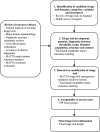Major Trauma Triage Tool Study (MATTS) expert consensus-derived injury assessment tool
- PMID: 38946735
- PMCID: PMC11210584
- DOI: 10.29045/14784726.2024.6.9.1.10
Major Trauma Triage Tool Study (MATTS) expert consensus-derived injury assessment tool
Abstract
Introduction: Major trauma centre (MTC) care has been associated with improved outcomes for injured patients. English ambulance services and trauma networks currently use a range of triage tools to select patients for bypass to MTCs. A standardised national triage tool may improve triage accuracy, cost-effectiveness and the reproducibility of decision-making.
Methods: We conducted an expert consensus process to derive and develop a major trauma triage tool for use in English trauma networks. A web-based Delphi survey was conducted to identify and confirm candidate triage tool predictors of major trauma. Facilitated roundtable consensus meetings were convened to confirm the proposed triage tool's purpose, target diagnostic threshold, scope, intended population and structure, as well as the individual triage tool predictors and cut points. Public and patient involvement (PPI) focus groups were held to ensure triage tool acceptability to service users.
Results: The Delphi survey reached consensus on nine triage variables in two domains, from 109 candidate variables after three rounds. Following a review of the relevant evidence during the consensus meetings, iterative rounds of discussion achieved consensus on the following aspects of the triage tool: reference standard, scope, target diagnostic accuracy and intended population. A three-step tool comprising physiology, anatomical injury and clinical judgement domains, with triage variables assessed in parallel, was recommended. The triage tool was received favourably by PPI focus groups.
Conclusions: This paper presents a new expert consensus derived major trauma triage tool with defined purpose, scope, intended population, structure, constituent variables, variable definitions and thresholds. Prospective evaluation is required to determine clinical and cost-effectiveness, acceptability and usability.
Keywords: expert consensus; injuries; major trauma; major trauma triage; trauma centres; triage tool.
© 2024 The Author(s).
Conflict of interest statement
None declared.
Figures
Similar articles
-
The accuracy of prehospital triage decisions in English trauma networks - a case-cohort study.Scand J Trauma Resusc Emerg Med. 2024 May 21;32(1):47. doi: 10.1186/s13049-024-01219-9. Scand J Trauma Resusc Emerg Med. 2024. PMID: 38773613 Free PMC article.
-
Injured patients who would benefit from expedited major trauma centre care: a consensus-based definition for the United Kingdom.Br Paramed J. 2021 Dec 1;6(3):7-14. doi: 10.29045/14784726.2021.12.6.3.7. Br Paramed J. 2021. PMID: 34970078 Free PMC article.
-
An economic evaluation of triage tools for patients with suspected severe injuries in England.BMC Emerg Med. 2022 Jan 11;22(1):4. doi: 10.1186/s12873-021-00557-6. BMC Emerg Med. 2022. PMID: 35016621 Free PMC article.
-
Folic acid supplementation and malaria susceptibility and severity among people taking antifolate antimalarial drugs in endemic areas.Cochrane Database Syst Rev. 2022 Feb 1;2(2022):CD014217. doi: 10.1002/14651858.CD014217. Cochrane Database Syst Rev. 2022. PMID: 36321557 Free PMC article.
-
A Canadian consensus-based list of urgent and specialized in-hospital trauma care interventions to assess the accuracy of prehospital trauma triage protocols: a modified Delphi study.Can J Surg. 2023 Mar 31;66(2):E181-E188. doi: 10.1503/cjs.019920. Print 2023 Mar-Apr. Can J Surg. 2023. PMID: 37001975 Free PMC article. Review.
Cited by
-
Refreshing the emergency medicine research priorities.Emerg Med J. 2023 Sep;40(9):666-670. doi: 10.1136/emermed-2022-213019. Epub 2023 Jul 25. Emerg Med J. 2023. PMID: 37491155 Free PMC article.
References
-
- Andaur Navarro C. L., Damen J. A. A., van Smeden M., Takada T., Nijman S. W. J., Dhiman P., Ma J., Collins G. S., Bajpai R., Riley R. D., Moons K. G. M. & Hooft L. (2023). Systematic review identifies the design and methodological conduct of studies on machine learning-based prediction models. Journal of Clinical Epidemiology, 154, 8–22. https://doi.org/10.1016/j.jclinepi.2022.11.015. - PubMed
-
- Bouwmeester W., Zuithoff N. P., Mallett S., Geerlings M. I., Vergouwe Y., Steyerberg E. W., Altman D. G. & Moons K. G. (2012). Reporting and methods in clinical prediction research: A systematic review. PLoS Medicine, 9(5), 1–12. https://doi.org/10.1371/journal.pmed.1001221. - PMC - PubMed
-
- Celso B., Tepas J., Langland-Orban B., Pracht E., Papa L., Lottenberg L. & Flint L. (2006). A systematic review and meta-analysis comparing outcome of severely injured patients treated in trauma centers following the establishment of trauma systems. Journal of Trauma-Injury Infection and Critical Care, 60(2), 371–378. https://doi.org/10.1097/01.ta.0000197916.99629.eb. - PubMed
-
- Coats T. J. & Lecky F. (2017). ‘Major trauma’: Now two separate diseases? Emergency Medicine Journal, 34(8), 494. https://doi.org/10.1136/emermed-2017-206788. - PubMed
-
- Cole E., Lecky F., West A., Smith N., Brohi K., Davenport R. & ELoTS Study Collaborators. (2016). The impact of a pan-regional inclusive trauma system on quality of care. Annals of Surgery, 264(1), 188–194. https://doi.org/10.1097/SLA.0000000000001393. - PubMed
LinkOut - more resources
Full Text Sources


